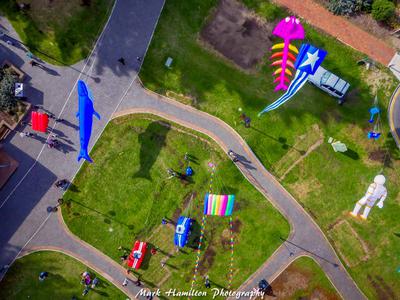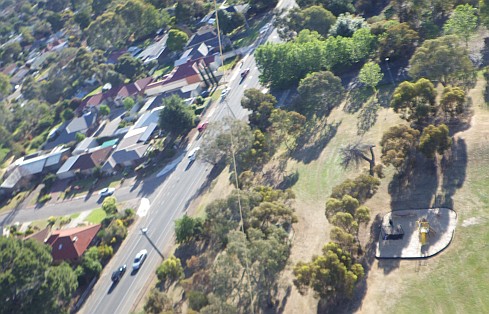- Home Page
- Aerial Photos
KAP Reports
Aerial Photos Using Big Dowel Kites
These KAP reports document what happened when some aerial photography was done in our state of South Australia over a period of several years.
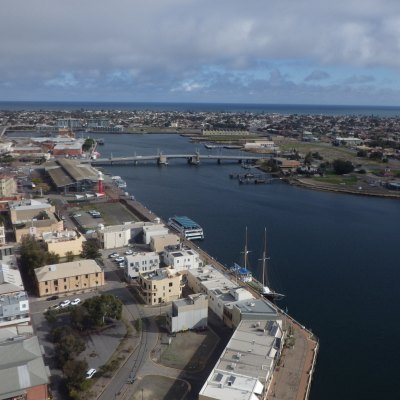 Port Adelaide from 300 feet
Port Adelaide from 300 feetThe Multi-Dowel Barn Door kite used to see most of the action, with the Multi-Dowel Sled getting pulled out in winds that were too light for the barn door.
A Fresh-Wind Sled was also created (which has a zero rig-time and a wide wind-range) and it ended up doing the bulk of my aerial photography flights. In fact, that Port Adelaide photo was taken under the Fresh-Wind Sled kite.
There's the huge barn door in the photo further down. A test weight is suspended in a bamboo tetrahedron, which was my first idea for a camera cradle.
The Multi-Dowel Barn Door tended to struggle above the 28-kph mark, so another design was created. This Fresh-Wind Barn Door (as I called it) used the same diameter dowel but had much less sail area and a whopping, big hole in the center. It flew right up into the 30 to 40 kph range.
Although suited to stronger winds, the Multi-Dowel Box kite proved awkward for KAP. The big traditional box design had a much longer setup time and was prone to sinking out to the grass while you were trying to get the camera into its cradle! However, it did successfully loft the camera rig on one occasion when the average wind strength was high enough.
Homemade KAP Cradle
After several different ideas were tried for making a KAP cradle, a simple solution based on bamboo BBQ skewers proved most practical. There it is in the photo.
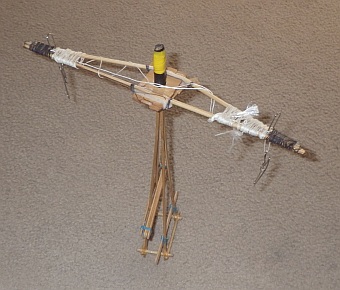 Skewers and paddle-pop sticks!
Skewers and paddle-pop sticks!The bamboo rig had these features:
- A loop of 20-pound Dacron was the suspension line.
- Four large paper clips served as pulleys for the half-Picavet suspension. Two were on the line, and two were secured to the cradle cross-piece.
- Four vertical skewers were brought together at the top through a hole in the cross-piece. Several turns of electrical tape prevented the skewers from slipping down and also provided some friction. Hence, with the friction fit, the camera could be pointed in any horizontal direction.
- Paddle-pop sticks were positioned and glued in place so the camera could be inserted and held in a slightly downward-facing direction. More ground than sky in the photos was the aim.
Once at a flying location, this rig was lofted several times, if required, to capture a different point of view each time. My standard sequence ended up being 20 frames at 10-second intervals.
Wind-Speed Handy Reference
Light Air
1-5 kph
1-3 mph
1-3 knts
Beaufort 1
Light breeze
6–11 kph
4–7 mph
4–6 knts
Beaufort 2
Gentle ...
12–19 kph
8–12 mph
7–10 knts
Beaufort 3
Moderate ...
20–28 kph
13–18 mph
11–16 knts
Beaufort 4
Fresh ...
29–38 kph
19–24 mph
17–21 knts
Beaufort 5
Strong ...
39–49 kph
25–31 mph
22–27 knts
Beaufort 6
High Wind
50-61 kph
32-38 mph
28-33 knts
Beaufort 7
Gale
62-74 kph
39-46 mph
34-40 knts
Beaufort 8
KAP Reports from Around Adelaide
And sometimes I went beyond the metropolitan area. Adelaide is the capital city of South Australia, one of the windiest states of Australia. Still you occasionally can't loft a camera at all, due to "no wind"! Perhaps a large R/C blimp would have come in handy on those days.
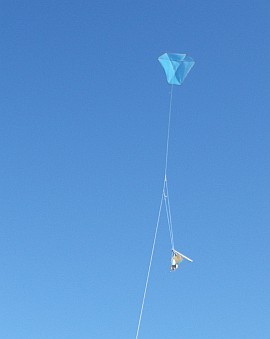 MBK Multi-Dowel Barn Door
MBK Multi-Dowel Barn DoorOK, here are the KAP reports. The most recent ones are first, although they are now all receding slowly into the past:
Port Adelaide—1 (Fresh Wind Sled)
Marion Shopping Centre—2 (Fresh Wind Sled)
Flinders University—1 (Fresh Wind Sled)
Happy Valley Reservoir—2 (Barn Door)
Marion Shopping Centre—1 (Barn Door)
Adelaide CBD—1 (Fresh Wind Barn Door)
Noarlunga Centre—1 (Fresh Wind Barn Door)
Happy Valley Reservoir—1 (Sled)
Wilfred Taylor Reserve—1 (Barn Door)
